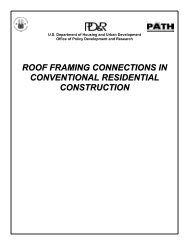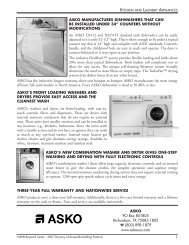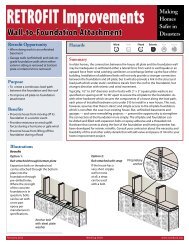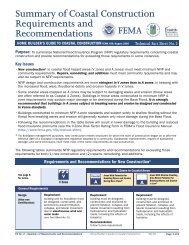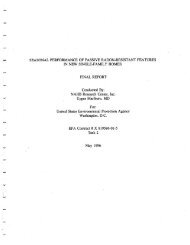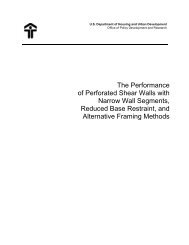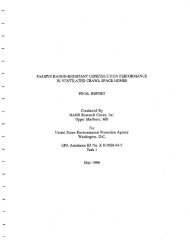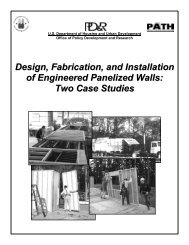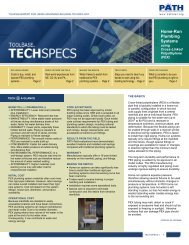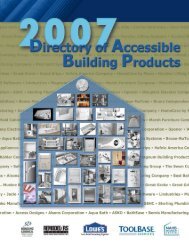The Rehab Guide, Volume 2: Exterior Walls - ToolBase Services
The Rehab Guide, Volume 2: Exterior Walls - ToolBase Services
The Rehab Guide, Volume 2: Exterior Walls - ToolBase Services
Create successful ePaper yourself
Turn your PDF publications into a flip-book with our unique Google optimized e-Paper software.
material must be scraped off, and windows and electrical devices protected or cleaned. Water is mixedwith cellulose in a “wet-spray” application. <strong>The</strong> water combines with the starch in the cellulose to form anatural adhesive, which holds the material in place. Excess material must be scraped off, but can bereused. <strong>The</strong> material must dry out before a finish is applied; excessive water can prevent drying and generaterot or mildew. High-density insulation filling cavities may improve fire safety.ADVANTAGES: Fills the cavities without settling. Visual inspection is possible to insure filled cavities. Greatlyreduces air circulation within walls. May improve fire safety.DISADVANTAGES: Bellying of the interior membrane may interfere with drywall installation. Sprayed-onfoam products are more expensive than batt or loose-fill installations, and are messy processes, requiringcleanup and protection. Excess water in wet-spray applications may lead to rot and mildew.5. INSTALL RIGID WALL INSULATION.A 3 /4-inch to 1-inch layer of rigid insulation, typically polyisocyanurate (ISO), molded expanded polystyrene(EPS), or extruded polystyrene (EPS), is a widely used adjunct to cavity insulation. Where cavity insulationcannot be installed, rigid foam may be the only way to insulate a wall. It is preferably applied on the outsideof the framing, keeping the framing warm enough in cold weather to prevent condensation within the walls,and inhibiting thermal short-circuits through the studs. It is also useful on the outside as a base for cementstucco or extorior insulation and finish systems (EIFS), although the latter should be part of an engineeredsystem that provides interior drainage. A layer of foam is essential in conjunction with conventional steelframing to prevent surface condensation. In Gulf-coast climates, a layer of foam behind the interior finish ispreferred over an exterior layer or a layer on both sides of the studs, especially with steel framing. Since foamcannot be relied upon to resist racking, it must be applied over structural sheathing or in parallel with asystem of wall shear bracing. Structural sheathing separated from the framing by an outside layer of foammay not meet code racking requirements (consult with a structural engineer). Celotex makes a structuralpolyisocyanurate foam sheathing that, when glued and nailed to the framing, acts as racking bracing. Woodsiding should not be applied directly to foam insulation.ADVANTAGES: Isolates framing to minimize or eliminate internal condensation and reduce cold bridgingthrough framing. Can add more than its rated R-value to a wall assembly.DISADVANTAGES: More costly per R than fiberglass insulation. If substituted for exterior sheathing,requires other measures to create racking resistance in the structure. Should not be used with EIFS exceptas part of an engineered system with interior drainage. EPS cannot support one-coat cement stucco overmore than 16" stud spacing.6. INSTALL A RADIANT BARRIER.While radiant barriers and coatings are commonplace in high-temperature industrial applications (typically500º F or more), they are marginally effective at ordinary temperatures. To be cost-effective in building applications,they must have a very low incremental cost (from 2 to 10 cents/sf, depending on the application). Clean,shiny aluminum foil facing a 3 /4 inch or deeper air space can create a radiant barrier. Foil-faced insulation heldback and inset-stapled creates only a marginally effective radiant barrier because the insulation bulges into theair space, and because the cavity can create heat loss through convection: it is always more effective to fill thecavity with insulation. If an air space is present for other reasons (for example, the cavity between sheathing andbrick veneer), facing the air space with foil-faced sheathing will add thermal resistance if the material remainsclean. A new form of radiant barrier is Radiance paint, which contains aluminum dust.ADVANTAGES: An easy way to add insulating value at brick cavity walls.DISADVANTAGES: Marginally cost-effective; unlikely to be effective if exposed to dirt or condensation. Not costeffectivein cold climates, except possibly Radiance paint. Seldom or never cost-effective if the air space isdeliberately “stolen” from conventional insulation. Foil may create a vapor barrier where one is not desired.7. INSTALL A STRUCTURAL INSULATED PANEL WALL.Rigid foam insulation adhered to structural skins can create a structural insulated panel (SIP). SIPsprovide a combination of structure and insulation. Depending upon the design, the panels may be42



